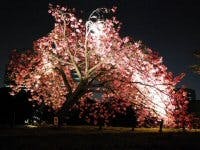In 2009, many of the existing lights were replaced with more energy-efficient, flower-friendly solid-state floodlights built with Luxeon® K2 with TFFC (thin-film flip-chip) LEDs from Philips Lumileds.
Nagasaki-based lighting manufacturer INEX Corp. developed the new LED luminaires with engineering support from Luxeon supplier Future Lighting Solutions, slashing energy use and carbon emissions by over 90% while simultaneously advancing Tokyo’s efforts to become a model low-carbon city.
“Sakura” season
The Japanese custom of viewing cherry blossoms - known locally as sakura - dates back to before the eighth century. Sakura bloom all over Japan from mid-January to early May, typically flowering in Tokyo in late March or early April. Visitors to Chidorigafuchi Park during the one- or two-week-long cherry blossom season are treated to vast expanses of flowering trees that can be seen from land as well as from boats traversing the moat that used to be part of the Imperial Palace grounds.
Lighting the trees at night is essential to support the tradition of after-dark flower viewing parties as well as to take full advantage of the short-lived season, but the existing halogen lighting failed to fit with energy-saving initiatives launched by Tokyo governor Shintaro Ishihara to conserve natural resources and fight global warming.
When park officials decided to climb on the ‘green’ bandwagon by switching to LED floodlights, they were unable to find an off-the-shelf product that met their requirements. That’s when they turned to INEX.
Building a better floodlight
The park needed several different outdoor solid-state luminaires with light outputs as high as 2,800 lumens. Fixtures would be placed either on the ground or on a stone wall to light the trees from below. INEX developed the basic board design but sought outside expertise on several engineering issues related to thermal management. The company also wanted to explore their LED product options because of dissatisfaction over color inconsistencies in a previous project that utilized non-Luxeon light sources.
“We knew we had to drive whatever LED we chose at a high current to hit the park’s target brightness levels, but we didn’t have time for extensive prototyping. We also needed to find an LED that would support that level of current and a way to ensure color consistency from LED to LED,” said Mr. Youichi Oda, President of INEX. “Future had the tools, expertise and narrow color bin selection to help.”
The color challenge was addressed with Future’s binning program, which offers 19 color bins for cool white Luxeon LEDS alone to ensure color uniformity within each shipment as well as from order to order. Future was able to guarantee a supply of LEDs from several cool white color bins that met the project’s specific requirements, giving INEX assurance that the color of their new floodlights would not vary perceptibly.
90% energy savings
In early 2009, the collaboration between the two companies culminated in INEX’s SKY HIGHBEAM-X, a family of floodlights that utilizes Luxeon K2 with TFFC LEDs along with custom-designed heat sinks, optics and drivers. The fixtures are available in both 7- and 14-LED models, with special weatherproofing measures devised to protect the fixtures from rain and dust.
The finished floodlights were installed in Chidorigafuchi Park between March 27 and April 10 to coincide with the annual cherry blossom festival. The fixtures are illuminated for 4-1/2 hours every night during the annual hanami (flower viewing) season.
The transition to solid-state lighting is saving the park an estimated 90% in energy usage and related costs for each replaced fixture, shrinking per-unit consumption from 150 to 15 kilowatt-hours. It is also reducing carbon dioxide emissions for all floodlights involved in the replacement program from 4.2 to just 0.2 metric tons during the cherry blossom festival alone, helping the park do its part to combat global climate change.
In addition, moving from halogen to LED floodlights with a far cooler beam and lower UV levels will help keep the cherry blossoms in peak bloom for as long as possible, maximizing park usage as well as the viewing pleasure of local residents. Saving energy and saving the flowers: that’s a big return on the park’s LED lighting investment.
At the same time, the SKY HIGHBEAM-X has become a staple of the INEX product line, offering high performance and an expected 40,000-hour or longer bulb life along with a low carbon footprint. The development work was inspired by cherry blossoms, but for INEX it is destined to bear fruit over and over - like the cherry trees themselves.









